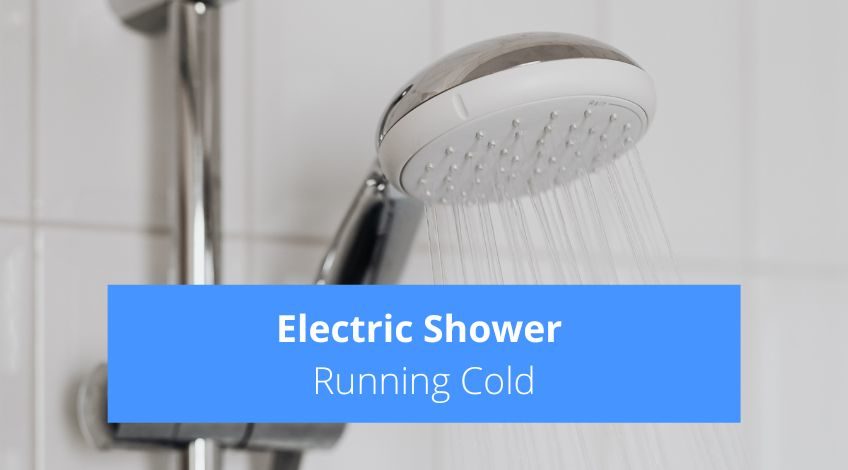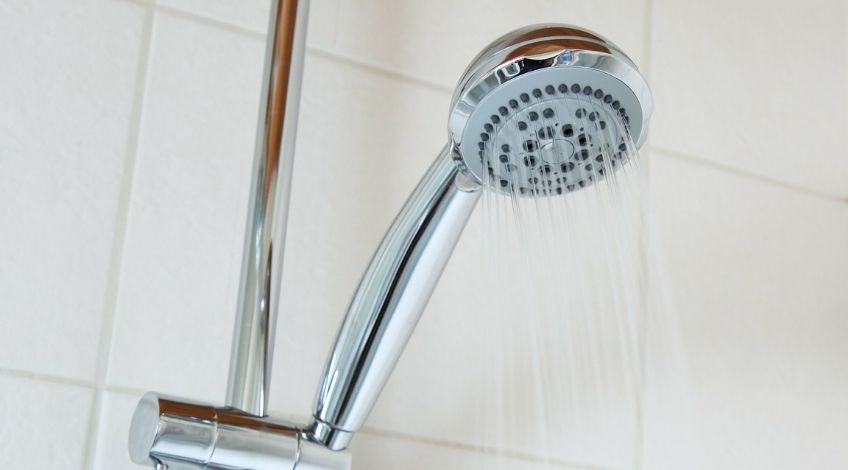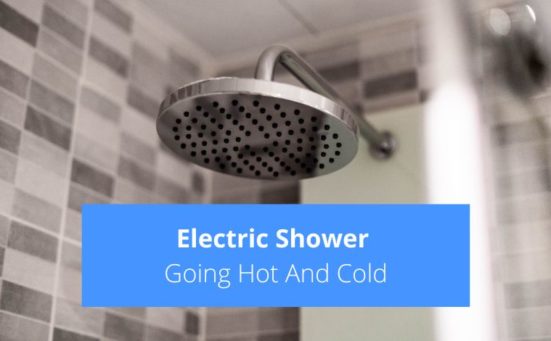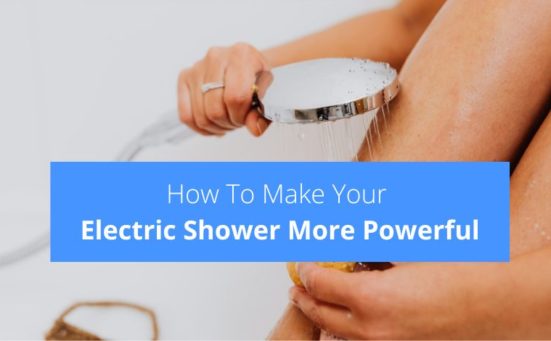
Electric Shower Running Cold? (here’s the reasons why)
Nothing beats the feeling of a hot shower first thing in the morning. There’s no better way to start your day than with a nice, hot shower. And there’s nothing worse than that lovely hot shower water running cold (usually just after you’ve applied shampoo to your hair).
If this is what’s happening with your shower, or if it just won’t run hot anymore, keep reading. We have identified all the possible causes for your shower to stop pumping hot water.
You Need To Understand How Electric Showers Work
Back in the old days before electric showers became a thing, the only way to shower was by using one of those over the bath showers. Not with the combination bath tap that diverts water to the shower head, that’s far too modern. I’m talking about a contraption consisting of a hose that connected to each tap which was connected to another hose with a showerhead.
As long as the household water tank had enough hot water, and the hose stayed connected to both taps, it was possible to enjoy a reasonably good shower. But the hot water was always an issue, in a family home there was never enough for everyone and somebody always ended up having to rinse off in cold water.
Modern Electric Showers
Once electric showers were invented and installed life was far sweeter, gone were the days when the hot water ran out mid shower. Suddenly everyone could experience a nice, refreshing hot shower every morning, it didn’t matter if you were first up or last up, there was always enough hot water.
How Do They Work?
Before we look at why your electric shower is running cold, you need to understand how an electric shower works, so you can visualise what’s gone wrong. If you know how an electric toaster works, you’ll understand the principle behind the electric shower.
An electric current is sent through a heating element which converts cold water into hot water. This hot water is stored in a small tank in the shower unit to ensure a constant supply of hot water as this is used, the element heats up more and so on. How the heat of that water is controlled depends on the model of shower you own.
Basic Electric Showers
In a basic electric shower, adjusting the temperature dial on the shower alters the amount of water that can pass by the heating element. The greater the amount of water that passes through the element, the hotter the water becomes.
Advanced Electric Showers
More advanced electric showers tend to be more complex and will use a combination of flow sensors, thermostats and pressure balancing valves to keep control of the water temperature. Some even have mixing tanks that mix hot and cold water to prevent sudden extreme fluctuations in water temperature if you adjust the temperature dial.
That’s a basic description of how an electric shower operates, so now we can look at what the probable cause of your shower problem is and possible ways to fix it.

Electric Shower Not Heating Up
To avoid the shower unit from short circuiting or allowing the water to get too hot, electric showers have built in safety measures. It’s usually a malfunctioning or damaged safety measure that’s the cause for the shower water not getting hot.
Also electric showers can fail to produce hot water due to a build up of limescale in the showerhead, shower pipes and filters. If you live in a hard water area, and it’s likely that you do, given that nearly 60% of the UK and 85% of the USA are designated hard water areas, minerals in the water calcify the working parts of any water based system over time.
Disclaimer: Never attempt to dismantle any electrical appliance before turning off the electrical supply and never touch any electrical equipment with the intent of taking it apart unless you are qualified to do so and understand completely what you’re doing. Failure to comply with this could cause accident, injury or loss of life.
Faulty Or Damaged Heating Element
The heating element is responsible for heating the water that passes through your electric shower unit. Faulty heating elements are the most common cause of electric showers constantly running cold. This could be caused by a number of issues, but usually it’s either corrosion or old age.
Before testing the heating element be sure to turn off the water supply and the electrical supply. As an extra safety precaution turn off the breaker that powers the shower to ensure you’re protected from a dangerous short circuit if your shower has developed faulty electrical wiring.
How To Troubleshoot The Shower’s Heating Element
- Isolate The Shower Unit
Ensure the water supply and electrical supply are turned off including the breaker that powers the shower. Then remove the shower’s cover. - Locate The Heating Tank
Once you locate the heating tank. Identify the wire connections coming from the heating tank. - Check The Wires For Continuity
You will notice the two wires are different colours, usually blue and black or in some units blue and brown. Place the black probe on your multimeter to the blue wire and the red probe to the black (or brown) wire. - Check For Resistance
The multimeter should be measuring in Ohms, if you get a reading of between 11 to 18, the heating element is working correctly. If you get a reading of 1 or 0 the element is blown and you’ll need to replace the heating tank.

Faulty Thermal Cut Off Switch
A faulty thermal cut off switch is another common cause for electric showers running cold. Thermal cut off switches or TCO as they’re commonly referred to, are basically a safety switch which is designed to automatically switch the shower off if the water temperature gets too high.
If your shower has a faulty TCO it could be shutting your electric shower down and turning off the heating capacity even if the water isn’t hot. The TCO can be checked by once again using a multimeter.
How To Check The Thermal Cut Off Switch (TCO)
- Isolate The Shower Unit
Ensure the water supply and electrical supply are turned off including the breaker that powers the shower. Then remove the shower’s cover. - Locate The TCO
It will usually be located on top of the heating tank. - Attach The Multimeter To The TCO
Attach one probe to each of the metal handles on the top of the TCO - Check The Multimeter
If the multimeter continues to beep while the probes are connected, the TCO is working correctly. If the beeping stops when the multimeter is connected to the TCO, it needs replacing.
Faulty Shower Mixing Valve
The more complex shower units have a water mixing tank to ensure a steady stream of water at the correct temperature. If the valve is faulty or just fitted in the wrong position, the water might be running colder than it should. This one really is best left to a professional, it’s time to call in a plumber.
Limescale Build Up In The Showerhead And Hose
If you’re not getting any water at all, it could be due to a build up of minerals from the hard water that supplies your household. This is pretty much unpreventable as it’s due to where the water comes from and as I said earlier around 85% of the US and around 60% of the UK naturally produces limescale due to hard water.
The naturally occurring minerals that cause this build up are calcium, iron, and magnesium. Over time they build up much like stalactites and stalagmites that form in caves, only on a smaller scale. If left, these build ups will eventually clog your pipes, taps and showers.
On top of which, if you’ve been using the same showerhead for some time, the pin sized holes that allow the water through can become blocked with the same mineral build up.
How To Fix A Blocked Showerhead
You will need vinegar, a plastic bag large enough to hold the shower head, and a rubber band or cable tie.
- Isolate The Shower Unit
Ensure the water supply and electrical supply are turned off including the breaker that powers the shower. - Remove The Showerhead From The Hose
If your showerhead is removable, remove it from the shower hose, if not omit this step. - Ensure Each Hole In The Showerhead Is Clear
Gently poke a cocktail stick or sewing needle into each hole in the showerhead to ensure none are blocked. - Thoroughly Clean The Showerhead
Using a safe detergent cleaner, clean the showerhead and remove as much of the debris and dirt as you can. - Fill A Plastic Bag With Vinegar
Pour enough vinegar into the plastic bag to completely cover the showerhead. Place the showerhead in the plastic bag ensuring it is fully covered by the vinegar. - Seal The Bag
Using a cable tie or rubber band, seal the bag with the showerhead immersed in vinegar and leave for 12 hours. - After 12 Hours Remove The Showerhead
Carefully remove the showerhead from the plastic bag and vinegar solution. Wash the showerhead using soap and water and reattach it to the shower hose.

Showerhead Filter Blocked
When removing the showerhead from the hose there is often a small circular washer with a metal mesh in the centre. This is a filter designed to prevent minerals from building up on the showerhead. This can become clogged with the same minerals which cause limescale build up.
To clean it use a nail brush or similar until you can clearly see the net shape on the filter. If it’s too clogged a replacement can be purchased for a minimal amount.
The Easiest Way To Fix An Electric Shower That’s Running Cold
If you have little time or even less mechanical knowhow, the easiest way to fix an electrical shower that’s running cold, is to call a plumber. Not only is this the easiest way, it’s the safest way too especially if you have never tackled a task like this before and you have no plumbing or electrical knowhow. Remember a little knowledge can be a dangerous thing.
This article is designed to advise you on what the problem could potentially be. It was never my intention to coach you into attempting any repair or otherwise unless you are fully competent and know exactly what you are doing. Always remember, safety first.
Also, follow us on Pinterest ...



